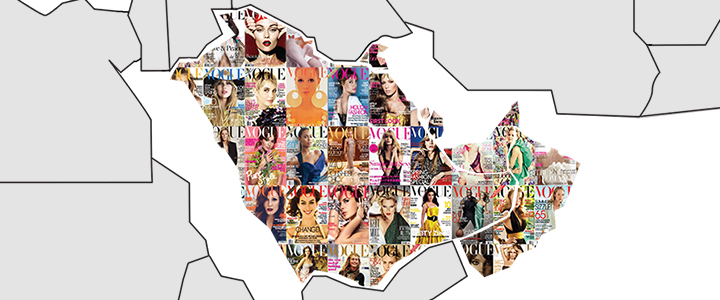
The booming Middle-Eastern economy has been drawing some of fashion’s biggest names to its shores, and with that a foray of fashion media. Only one magazine remains absent from news stands, the world's most prestigious, Vogue. Hiba Mohamed examines why the luxury lifestyle monthly has not made an appearance in the region yet and if it ever will.
It’s no secret that Khaleeji women have long had a penchant for high fashion. Although rarely spotted on the front row, four generations of Middle Eastern women have been fueling the once ailing couture industry. According to a Euro Monitor report (2011) the UAE’s luxury market is said to be worth £600 million and fashion’s major players have duly taken note "The huge power of Islamic currency has been a tremendous driver in the way that all major Western fashion houses have run their businesses in recent years," writes Alexandra Shulman, editor of British Vogue.
In the same wave there has been an explosion of fashion media launching regional editions, with Marie Claire setting the pace in 2008 in the Lower Gulf, followed by Marie Claire Saudi Arabia in 2009. In the same year Harper's Bazaar Arabia went into publication and Elle Arab World launched in 2010. On the local front, there have been some strong Arab fashion publications coming through in the last couple of years, yet the world’s most influential fashion magazine, Vogue, has not made its appearance on this international newsstand.
In 2007 a Dubai publishing company approached Condé Nast with a proposal to publish Vogue Middle East but Chairman Jonathan Newhouse rejected it. In response, Alex Aubry who contributes for Harper’s Bazaar Arabia launched a blog, The Polyglot, to challenge perceptions about the Middle East.
It is clear that much has changed in the Middle East in the last twenty years, and particularly since the 9/11 tragedies. The Muslim world was forced to question their identity. Princess Reema Bandar-Al Saud says in Vogue, “We had to decide who we were- do we choose to be positive members of the world and flourish that way or do we allow others to define who we are?”
British Vogue contributor, Kathleen Baird-Murray notes, “2001 divided people, but now fashion is starting to bring people together.”
Yet time has a way of healing old wounds. Through a shared appreciation of fashion, cultural bridges have transformed perceptions of the Middle East. “Due to the private nature of our communities here access was previously limited. Today with the advent of social media and more access to the Middle East and frankly the development of cosmopolitan dynamic cities all over the Middle East it is easier to get to hear our voices,” explains Al Saud.
Until recently the Arab luxury retail market has been somewhat neglected, a major factor that could contribute to the decision to launch a Vogue Arabia. With the high level of fashion brands that are now available for the first time in the Middle East, luxury brands need a reason to advertise in magazines. “If a brand like Dior or Chanel has a lot of stores in Dubai or Beirut it has a reason to advertise because it is trying to appeal to locals,” explains Aubry.
It is safe to say that the mood in Condé Nast may have changed, the media powerhouse recently opened Vogue Café in Dubai Mall and launching Condé Nast Traveler Middle East, last May. It appears that the market is ready for a publication like Vogue and yet the publishing house seems reluctant to rush into the Arab market.
In most cases an international edition of Vogue represents one country like Russia or China but it’s a far more challenging prospect to represent a region as diverse as the Gulf. “There is a tendency to lump the Middle East into one group. As soon as any magazine comes to the surface that is trying to represent a region, you have to keep in mind you are trying to speak to someone in Beirut, Jeddah, and a Qatari girl living in L.A.” explains Aubry.
“Each Gulf nation has its own voice and style and that is what makes our region so dynamic,” Al Saud confers. At a time when so much is in flux, it is important to remember the region’s rich cultural heritage,” says Aubry. “There are many examples of emancipated women dating from the 1900s -1920s in Tunis, Egypt and Palestine, while the 1960s and 70s saw women from the Arabian Gulf traveling overseas to get higher degrees and coming back to their countries as the first lawyers, educators and doctors.. If you are going to have a magazine like Vogue, it needs to convey those histories as well,” says Aubry.
"It is not so much of a matter of wanting or needing our own Vogue," says Al Saud. “A balanced international view of the Middle Eastern woman is what is needed.”







